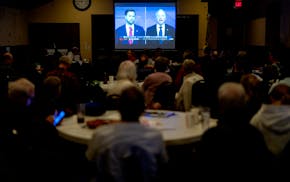Democratic legislative negotiators reached a higher education spending deal Monday night that would create a free college tuition program for Minnesota residents whose families earn less than $80,000 a year.
If passed by the state House and Senate, qualifying Minnesotans would no longer have to take on debt to get a public college degree. Members of the Legislature's higher education budget conference committee will detail the agreement during a hearing Tuesday afternoon.
"We've been seeing declining enrollment on all campuses," said Senate Higher Education Committee Chair Omar Fateh, DFL-Minneapolis. "If we don't do something quick, we're at risk of shutting down some campuses. … I see this bill as an enrollment driver."
House Higher Education Committee Chair Gene Pelowski, DFL-Winona, said the proposed free-college program could help alleviate the state's labor shortage.
"This is the type of thing that we need to do to ensure that we have a skilled labor workforce that can get into that workforce and not have to incur debt," Pelowski said.
Minnesota would spend about $117 million in fiscal year 2025 to get the program started, according to the budget deal. After that, the state would spend $49.5 million annually on the program.
Rep. Marion O'Neill, the only Republican on the conference committee that crafted the higher education budget agreement, said she was "completely frozen out of all discussions."
"Everything was done in secret and between the two chairs," said O'Neill, R-Maple Lake. "I haven't even reviewed it yet. It was a shame."
Qualifying students would have to attend a public community college or four-year university in either the University of Minnesota or Minnesota State systems, or a tribal college. The new state program would not cover private college tuition.
Eligible students would have to be state residents, have a family income below $80,000, be enrolled in at least one credit per semester, be in good academic standing and complete the Free Application for Federal Student Aid (FAFSA), which determines their state and federal grant eligibility.
The income cutoff is strict. Families making exactly $80,000 or more would not qualify.
The "North Star Promise" would be a last-dollar scholarship program, meaning it would cover any tuition costs that are leftover after state and federal grants and institutional scholarships have been applied.
Public colleges and universities would not be allowed to reduce the aid they award students in hopes that the state would pick up more of the tuition tab.
"I honestly believe that this is the most transformational and impactful higher education budget in our nation," Fateh said. "We're opening the doors for all of our students."
The budget also includes big state funding increases for the University of Minnesota and Minnesota State systems.
Mike Dean, executive director of the community college student association LeadMN, praised Democratic lawmakers for taking "bold action to make college affordable."
"Minnesota high school graduates now know that college is not just for wealthy families, but is an option for all young people who are willing to put in the work to go to college," Dean said in a statement Monday night. "This comes at a critical time when Minnesota needs more nurses, welders and teachers but students struggle to afford the education that they need to enter the workforce."
Former DFL Senate Majority Leader Kari Dziedzic dies of cancer at age 62

How the Star Tribune is covering the 2024 election

Fact check: Walz and Vance made questionable claims during only VP debate

In Tim Walz's home city, opposing groups watch him debate on the national stage

![The exterior of the Minnesota State Capitol Tuesday, May 7, 2013 ] GLEN STUBBE * gstubbe@startribune.com EDS, for any file use ORG XMIT: MIN13](https://arc.stimg.co/startribunemedia/KKSNMLOHCMHLG5ID3YDXXM4K4A.jpg?w=600&h=600&auto=format%2Ccompress&cs=tinysrgb)